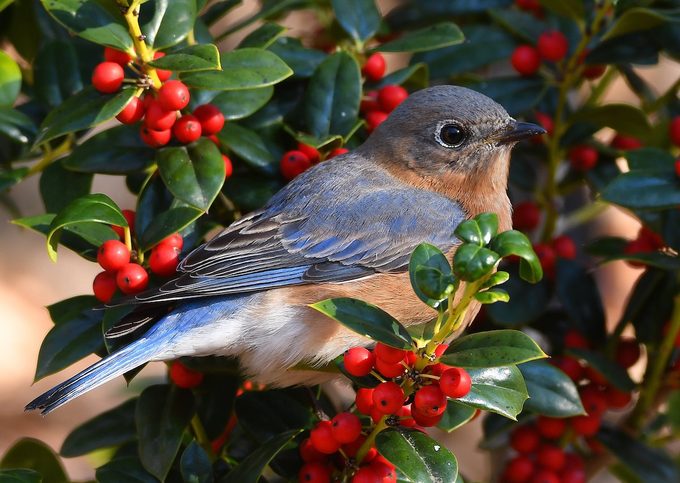Crow on Holly Tree Drawing
Every editorial product is independently selected, though we may be compensated or receive an affiliate commission if you buy something through our links. Ratings and prices are accurate and items are in stock as of time of publication.
Uncover fascinating holly tree facts, including which tree is best for your backyard birds and how many species of holly exist.
Haul out the holly! Of all the decorations we hang in the winter months, holly has one of the longest and most interesting histories and is a great choice for your backyard birds that eat berries. Find out which holly tree is best for attracting your favorite feathered fliers. Then check out a few holly tree facts to impress your family and friends at the dinner table, too.
Discover 7 fun facts about Christmas trees.
Ask the Experts: Which Holly Tree Is Best for Backyard Birds?
Melinda Myers: First make sure you have the right growing conditions for hollies and enough room for at least one male for every one to five female plants. Without both, the female plants won't produce berries. Hollies prefer moist, acidic soil, and evergreen hollies need shelter from winter's cold winds and bright sun, which can both have a drying effect.
American holly (Ilex opaca) is native and may be a good choice. It's a large tree that serves as a host plant for several caterpillars, and birds adore the berries. Or consider the deciduous winterberry (Ilex verticillata), a shrub that grows between 3 and 12 feet tall. It's hardy in Zones 3 to 9 and loses its leaves in winter, revealing berry-covered branches.
Check out the top 10 trees and shrubs with berries for birds.
There Are Many More Species Than Traditional English Holly
More than 400 species, in fact. They all belong to the genusIlex, and they're found around the world in tropical, sub-tropical, and temperate zones. In the U.S., you'll generally find them growing in zones 6 – 10, with many native species available in most areas. (For those who think they live too far north to grow holly, look into the so-called "Blue Hollies," a hybridized group said to be hardy to zone 4.) Learn everything you need to know about choosing and growing hollies from the Holly Society of America.
"The Holly and the Ivy" Tells the Story of Christ
Although most of us only know the song's first verse ("The holly and the ivy / When they are both full-grown" / Of all the trees in the wood / The holly bears the crown") the later verses draw parallels between the thorny leaves and the crown of thorns Christ was said to wear, the bitter bark and his suffering, and so on. The holly referred to in the song, by the way, was English Holly (Ilex aquifolium), which is the only species that is native to most of Europe.
Psst—we love this Scandinavian Christmas tradition for the birds.
Holly Was a Winter Holiday Decoration for Thousands of Years

Long before Christians used holly to decorate their homes and churches at Christmastime, other cultures brought holly branches in to brighten things up in the winter. Druids used holly as part of their winter solstice celebrations at least two thousand years ago. Reportedly, they believe that the Holly King, having defeated the Oak King, rules over the darker winter months. (In the summer, the Oak king rules triumphant once again.) Romans associated holly with Saturnalia, celebrated around the same time. As Christmas became more popularly celebrated in the winter, holly naturally became a part of the festivities, as well.
If you enjoy holly tree facts, check out our facts you didn't know about daisies.
Don't Cut Down That Holly Bush! It's Protecting You From Lightning Strikes
While older cultures happily trimmed holly branches to bring indoors, they felt it was very bad luck to cut down a holly entirely. One popular belief was that the thorns on holly bushes drew lightning, keeping it away from homes and barns. Interestingly, there seems to be some scientific basis to this! According to the Holly Society, "We now know that the spines on the distinctively-shaped holly leaves can act as miniature lightning conductors, thereby protecting the tree and other nearby objects." So feel free to prune your holly and cut branches for the holidays, but you might be tempting fate to cut it down entirely!
We found 8 types of Christmas trees you can grow.
Holly Berries: Great for Birds, Not Humans

The last of our holly tree facts might turn your stomach. Birders and gardeners know their feathered friends love to feast on holly bushes' berries—technically, hollies have drupes, notberries, but we're not going to get overly technical. But holly berries, leaves, and bark are all mildly toxic because they contain theobromine, a substance similar to caffeine. In small amounts this won't really affect humans, but large amounts can bring on stomach issues and more. (In fact, one species of holly native to the southeastern U.S., known as Yaupon Holly, has the terrific botanical name Ilex vomitoria.) Native Americans even used some of these species in traditional medicines to induce vomiting.
While birds can handle the toxicity of the berries, pets like dogs and cats cannot. (Try these pet friendly indoor plants instead). It's best to keep live holly decorations out of your pets' reach, and be cautious when planting holly in your yard if your pets like to snack on your plants. And if you like to snack on your plants, consider planting these edible flowers instead.
Source: https://www.birdsandblooms.com/gardening/growing-trees-shrubs-grasses/five-fascinating-facts-about-holly/
0 Response to "Crow on Holly Tree Drawing"
Post a Comment